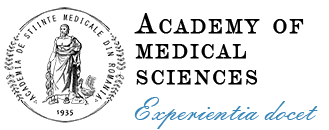The second scientific research program coordinated by the Academy of Medical Sciences (A.S.M.) and the first strictly medical-themed program was titled the National Research-Development-Innovation Program for Life and Health “VIASAN”.
During the period 2001-2006, the Romanian Government, through the Ministry of Research and under the National Authority for Scientific Research, authorized A.S.M. to fully lead this research program with strictly medical objectives from our scientific history.
The “VIASAN” Program coordinated a total of 422 research projects during the mentioned period, carried out by physicians and scientific researchers from 12 Universities, 14 national Institutes, 2 units of the Romanian Academy, 29 hospitals with research centers, 17 research-active companies, and 7 non-governmental organizations. Analyzing the project leadership, it emerged that out of all these, 264 projects were led by university staff, 90 by primary care physicians, 68 by scientific researchers of groups 1 and 2, and two projects by members of the Romanian Academy. Young researchers who underwent training internships in laboratories abroad and attended intensive courses on specific topics related to the funded projects also participated in scientific research activities. This specific medical research program aimed, within the provisions of the National Program for Romania’s accession to the European Union, to correlate its scientific objectives with those of the thematic program “Quality of Life and Resource Management of Living Beings”.
It is worth mentioning the establishment, for the first time in national medical research, of the first centers of excellence in specific fields, such as: the center of excellence for scientific and technological research in tissue transplantation and skin grafts, established at the Grigore Alexandrescu Hospital in Bucharest under the leadership of Prof. Dr. Dan Enescu; the center of excellence for research and diagnosis in peripheral nerve pathology developed at the “Bagdasar-Arseni” Hospital in Bucharest, under the coordination of Prof. Dr. Alexandru Vlad Ciurea.
New specialties nuclei have been developed within hospitals and research centers with new competencies, including: the development in Romania of the first regional bank of stem cells from umbilical cord and placenta blood, tissue and organ transplantation, stem cell therapies, microsurgery and laparoscopic surgery, gene therapies for severe chronic lower limb ischemia, and the development of multifunctional robotic systems in neurosurgery, among others.
The theoretical results, experimental achievements, and clinical outcomes obtained within this national program have allowed institutes, centers, and expert groups to establish important European scientific partnerships within the ongoing program.
The structure and objectives of the program were established based on the following considerations:
- The state of Health and related fields that require significant efforts to reduce the gap between Romania’s development level compared to the EU;
- The specificity of activities in Romanian medical research;
- Provisions of the National Program for Romania’s accession to the EU;
- Correlation with the specific objectives of the thematic program “Quality of Life and Resource Management of Living Beings”.
- The promotion and support of basic, strategic, and applied research to understand the mechanisms of human illness, to treat pathological conditions, and to prevent diseases with a significant impact on the population;
- Developing knowledge in the field of medical sciences and defining applications in the pathology of children, adolescents, adults, and the elderly;
- Developing and using medical and scientific information networks; optimizing medical information management;
- Developing and implementing new advanced clinical investigation and treatment techniques to create banks of organs, bones, tissues, and sets for prosthetics and implantology; organ transplantation development;
- Closing the existing gap compared to the European level regarding medical services;
- Developing and harmonizing the system of clinical norms and procedures in accordance with the requirements of European and international standardization bodies;
- Promoting multisectoral and multidisciplinary research in line with other fields such as biophysics, biochemistry, and biotechnology, to understand and correlate medical results in the current modern context;
- Developing facilities and services to support research in the field (networks, centers, service centers, etc.), as well as promoting and disseminating knowledge and results obtained within the program;
- Cellular processes in biology and pathology;
- Degenerative chronic pathology: cellular mechanisms of production, prevention possibilities;
- Child and adolescent pathology;
- Infectious pathology;
- Medical therapy, characterization, and control of drugs;
- Public health and epidemiology;
- Advanced medical technologies for introduction into medical practice;
- New information solutions for management, research, and medical practice;
- Unconventional techniques in pathology of high human performance demands;
- Diagnosis and control of metabolic and adaptive processes in high-performance sports.
- During the following period, complex fundamental and applied research activity took place in the medical, biological, and biotechnology fields.
Important concerns involve A.S.M.’s involvement in the realization of national excellence research programs in health (CEEX), to have good collaboration with those who develop health policies and with other structures of the health system.
